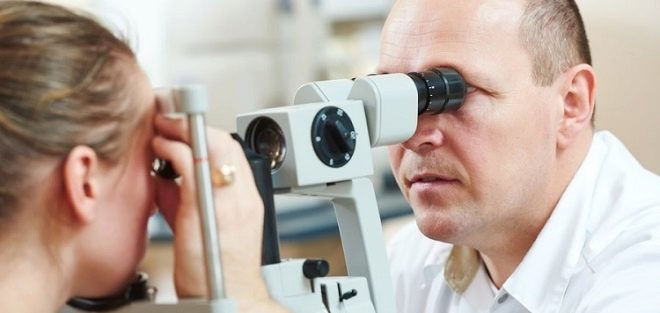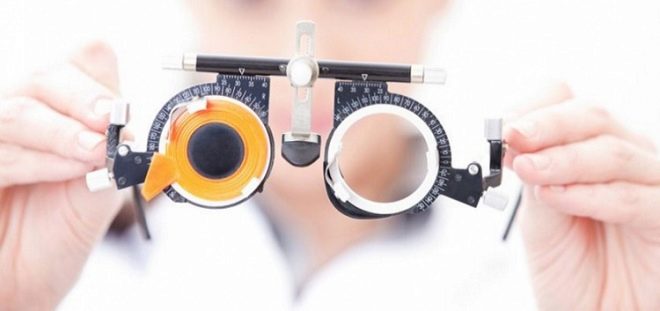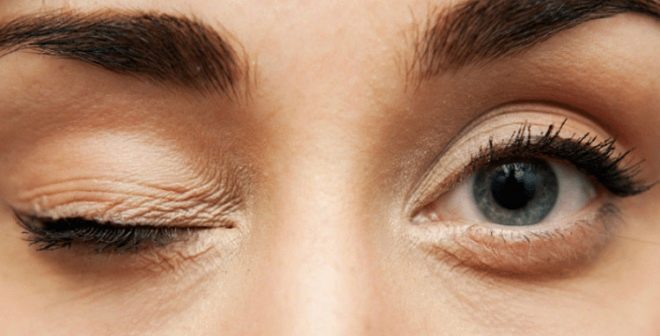Eye Diseases Psychosomatics
Visual diseases are widespread in childhood and among adults. And it is often very difficult to understand why they arise, because objective reasons are not always possible to establish.
In this article we will talk about the psychosomatic prerequisites for the development of eye diseases.
general information
The eyes - a paired sensory organ that helps us form a picture of the world - to take an image and transmit it to the analyzing centers of the brain. Violation of the eye greatly impairs the quality of human life. Eye health is studied by ophthalmology, and a doctor specializing in the treatment of such problems is called an ophthalmologist or an ophthalmologist.
The organs of vision can suffer in many circumstances, can lead to the development of pathology capable of a variety of diseases. Eye problems are not always limited to the organs of sight, often dysfunctions become a manifestation of another existing ailment.. A separate group are congenital anomalies of the visual organs, tumor processes, traumatic injury. The remaining diseases can be divided into infectious and non-infectious.
In both children and adults, the mechanisms of development of problems with organs of sight are similar. Poor eyesight can develop on the background of diabetes, hypertension, tuberculosis, syphilis. There are also parasitic diseases, when the organs of vision are affected by one parasite or another: demodicosis, ophthalmomyasis, cysticercosis.
The most common diseases are:
- cataract - clouding of the lens with partial or complete loss of vision;
- glaucoma - increase of intraocular pressure in violation of certain functional capabilities of the organs of vision;
- myopia (myopia) - image formation not on the retina, but in the space in front of it;
- retinal detachment - stratification of the reticular and choroid;
- retinopathy - polyfactor retinal position;
- retinoblastoma - a tumor of a retina of malignant type;
- color blindness - inability to distinguish all or some colors;
- blenorrhea - inflammation of the shell of the eye, mainly caused by gonococci;
- keratitis - inflammation in the cornea;
- strabismus - deviation of the visual axes with the discoordination of the eyes, a violation of focus;
- keratomalacia (dry eye syndrome) - dryness of the cornea, most often developing on the background of vitamin A deficiency;
- astigmatism - blurred vision due to the defeat of any part of the eye;
- conjunctivitis - Inflammation of the conjunctiva.
Psychosomatic causes
Psychosomatic medicine takes into account not only the physiology and anatomical nuances, but also the psychological state and emotional background of a person, since, as is known, many diseases have a psychosomatic basis.
From the point of view of psychology, the eyes are the connecting important link between the person and the world around. With their help, you can see and receive visual information. Despite the fact that the list of ophthalmological ailments is quite long, the causes at the metaphysical level are usually similar in conjunctivitis and in cataracts.
Experts in the field of psychoanalysts and psychosomatics believe that eye diseases develop in adults and children who do not want to see something or someone. This applies not only to the people around them, but also to the events around them.
If something does not suit a person so much that he internally chooses not to look at it at all, gradually protection at the subconscious level is developed against the traumatic factor — the body simply reduces vision or creates obstacles to vision: glaucoma or cataract.
Agree, not everything that we see with our eyes gives us pleasure. But not all diseases develop. The secret is not how we evaluate what we see, but how we treat it..
If a person experiences strong heartache from what he sees, if what he sees causes hatred, anger, and anger in him, then the very protective mechanism that is directed solely for good is gradually activated: eliminate the vision, so that the person becomes calmer and does not destroy himself negative, heavy emotions and experiences.
People who are able to perceive negative information philosophically usually retain their excellent vision to a very old age.
It is believed that the right eye symbolizes the outside world and everything male, and the left one - the perception of the internal world and all women. Thus, a person who suffers from the right eye has problems with the perception of events and people, patients with pathologies of the left eye have problems with the perception of themselves. If both eyes are affected, there are problems both inside and out.
Another reason why eyesight deteriorates, and eye pathologies develop, lies in the fear of facing the truth, seeing reality as it is. So, myopia or farsightedness is often seen in children from dysfunctional families, where parents lead an unattractive lifestyle and shame on their children.
Also, pathologies of organs of vision can occur in people who are afraid of the future, because fear literally makes it impossible for them to see far, clearly and clearly.
Causes of disease and ways to overcome
General psychosomatic principles usually do not make it easier to understand the causes of certain ailments, namely, people seek help in identifying them and come to specialists in the field of psychosomatic medicine. So let's take a closer look at some of the common ophthalmic pathologies.
Nervous eye tick
This is more of a neurological problem, but since it is related to the eyes, it should still be told about it. The eye is usually twitching with a significant internal stress, which occurs in a person if something is unpleasant for him, and he does not want to see it.
It is necessary to carefully observe when a tick arises, how long it lasts, whether vision suffers. It is also necessary to pay attention to people who are present in front of a tic in the field of view of a person, as well as to events.
Usually a few weeks of observation is enough to identify the "culprit." Then you just have to try to change your attitude to the event or person.Try to relax whenever an irritant occurs on the way.
Keratomalacia (dry eye)
The irritation and discomfort that occurs with such a pathology clearly indicate that the reason lies in the excessive irritation that a person suffers for one reason or another. Often, people react to colleagues, to a spouse (spouse) in this way if the relationship is at a dead end, and people are forced to stay close and look at each other daily.
If there is a strong burning sensation due to dryness, then you should think about whose address and how often you sneak.
The method of deliverance is based on the revision of his attitude towards others, teaching the techniques of anger management. When nothing helps, you should eliminate your presence in a traumatic environment - change jobs or part with a partner who, apart from irritation, does not cause any positive feelings.
Myopia
This attack is characteristic of those who are afraid of the future, can not look into the distance in the literal sense of the word. Such people tend to “hide their heads in the sand” as soon as they need to look beyond their nose.They are sometimes so focused on their own experiences, so subjective that they simply cannot look at the situation as a whole, assess different points of view.
In children, myopia often develops as a protective mechanism against parental conflicts and quarrels with peers.. To reduce anxiety and feelings, visual impairment subconsciously occurs.
Assistance is needed on a large scale - after identifying the problem, new positive attitudes should be created for the future, for people, to be sure that the future is beautiful and amazing.
Farsightedness
In contrast to myopia, hyperopia develops in people who try not to notice their shortcomings, but with ecstasy consider and study events on a global scale. It is unpleasant to them today, close, but the distant, great seems tempting.
You need to find the reason for denying yourself or something in your inner circle and eliminate it..
Astigmatism
The development of such a disease suggests that there is a severe internal conflict that makes it difficult to compare the internal and external world, as a result, the look is fuzzy, blurred. Astigmatics are often convinced that they are completely correct, and the world around is far from perfect. Denying themselves as part of the world, they cease to see the real picture of him.
In treatment, it is important to get psychotherapeutic help, designed to balance your own “I” with the general state of affairs. You need to correctly calculate your strength, accurately assess the situation, set goals and achieve them.
Strabismus
In children, it develops if the baby lives in an atmosphere of contradictions. Parents can not come to a common opinion, they have different requirements for the child, to the issues of education. Contradictory requirements in this case influence the formation of two different views on one problem.
In adults, strabismus develops due to the equally strong influence of two worlds: the existing and the illusory, the fictional, invented by the patient himself.
The elimination of inconsistencies usually makes it much easier to ophthalmologically correct such a pathology.
Glaucoma
These are the insults of a person pressing on the eye from within. He looks at the world through the prism of offenses, he remembers them in detail, to the smallest detail, adds new offenses to the old ones, thanks to which the intraocular pressure increases.
Glaucoma is treated by identifying offenders and situations in which the patient has been offended.. Then all you need to do - forgive them all, let go of all situations, ease internal stress. It is not quick, and rather difficult, but worth it.
Barley
This unpleasant and painful condition arises in the event of a strong, sharp anger, which the man managed to contain inside. He finds a way out - there are boils that fester and ache. Frequent barley in a child or adult is a sign of a general suppressed emotional background.
Such a person needs to learn to relax and throw out his anger, if it arises, in a positive direction: to go in for sports, begin to conquer mountain peaks or dance tango. All that gives the release of energy - optimal in this situation.
Conjunctivitis
Developed due to accumulated irritation from what he saw. Inflammation, redness, swelling - a sign of severe anger that a person has been experiencing for a long time and tries not to show to others. The eyes are itchy and watery because this irritation on the verge of aggression needs getting out.
It will help to reassess attitudes towards loved ones and yourself, as well as in the case of barley, need to learn to realize negative energy into something positive.
Cataract
The clouding of the lens suggests that a lot of “muddy” attitudes have accumulated in a person, most often associated with his heavy memories of the past. The patient would be happy to get rid of them, but cannot, because they are in his own way dear. Gradually, the body begins to block the channel, but not the past, but the present, which urgently requires getting rid of old experiences.As a result, today begins to be perceived blurry.
Therapy is obvious - revising and sending "to the scrap" all heavy memories by the method of their depreciation.
Injuries and swelling
Even eye injuries (bruises, injuries) do not arise by chance. Psychosomatic causes are preventative - a person needs to urgently reconsider his vision of the world, he is on the wrong path, which will lead to more negative problems with organs of sight. If you do not do it now, then you shouldn’t be surprised that your eyesight is falling, purulent inflammatory processes develop.
Swelling, bags under the eyes - a sign of internal weakness, lack of will to change, stagnation of old, disastrous memories, insults and attitudes.
Vision problems in most cases can be avoided if you look at the world through the prism of a good and fair attitude to him and to himself. The search for the causes of congenital malformations should be sought in the attitudes of the parents of the child.


















